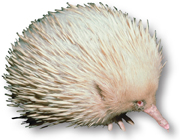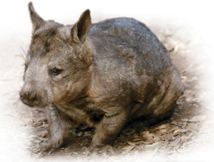The three living groups of mammals are the monotremes, the marsupials, and the placentals. There are about 5000 species of mammals, usually divided into about 26 orders, most of which are placentals. There is only one order of monotremes.
MONOTREMATA: Monotremes
Monotremes—egg-laying mammals—share two important characteristics with reptiles. First, the digestive, reproductive, and urinary systems of monotremes all open into a cloaca similar to that of reptiles. Second, monotreme development is similar to that of reptiles. Like a reptile, a female monotreme lays soft-shelled eggs incubated outside her body. The eggs hatch in about ten days. Unlike reptiles, however, young monotremes are nourished by mother's milk, which they lick from pores on the surface of her abdomen. Only five monotreme species exist today, all in Australia and New Guinea. Examples: Duckbill Platypus, echidnas

Short-Beaked Echidna (Albino)
MARSUPIALIA: Marsupials
Marsupials bear live young at an extremely early stage of development. A fertilized egg develops into an embryo inside the mother's reproductive tract. The embryo is then “born” in what would be an embryonic stage for more familiar mammals. It crawls across its mother's fur and attaches to a nipple that, in most species, is located in a pouch called the marsupium. The embryo spends several months attached to the nipple. It continues to nurse until it can survive on its own. Examples: kangaroos, wallabies, wombats, opossums

Wombat
Table of Contents
- Formulas and Equations
- Applying Formulas and Equations
- Mean, Median, and Mode
- Estimation
- Using Measurements in Calculations
- Effects of Measurement Errors
- Accuracy
- Precision
- Comparing Accuracy and Precision
- Significant Figures
- Calculating With Significant Figures
- Scientific Notation
- Calculating With Scientific Notation
- Dimensional Analysis
- Applying Dimensional Analysis




